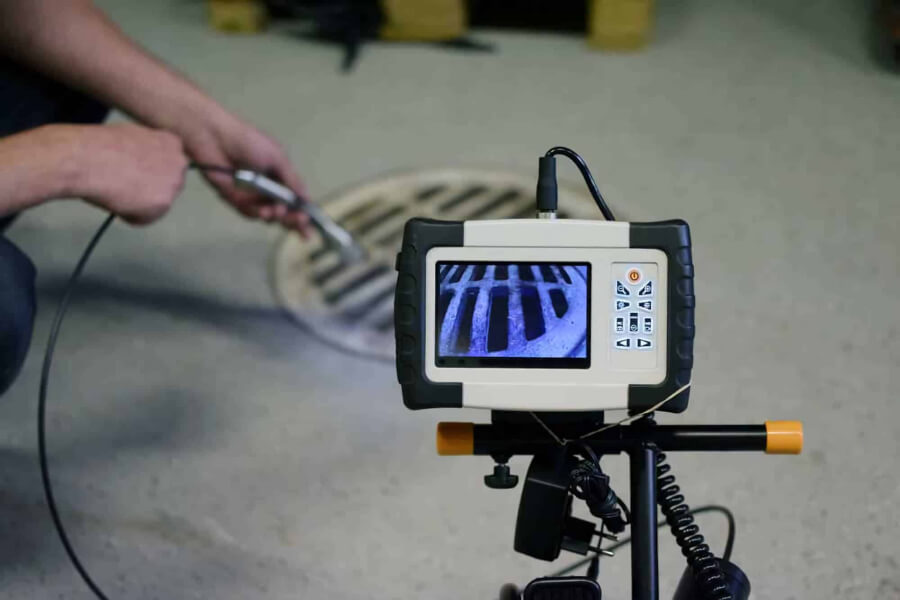How To Find A Residential Sewer Line
It is important to note that all the drain pipes in your house go into one main sewer line, which is then connected to a septic tank or a municipal sewer system. Ultimately, if all the drainage from the home falls into one main sewer line, you must know where this line is located.
You may be planning on introducing changes in your plumbing structure, or there may be an issue like a clog or a leak that requires you to locate sewer lines.
If you make changes to your house, like installing a new sink or toilet, you need to connect the drainage to the sewer line, or you may contaminate the clean water supply.
If you don’t know the sewer line location in your house, you can use multiple sewer line-finding techniques, including hiring a professional sewer line finder.
Here are some easy to find the underground water line:
Method 1: Using A Pipe Locator
Most professionals use a pipe locator to find water pipes underground. These are usually available in your local hardware stores and also online. Their cost can vary; the most expensive can cost over $1000. Here are simple steps taken to use the pipe for locating sewer lines:
Align The Frequency
A typical pipe locator has two parts: a long transmitter line inserted in the pipes and a handheld locator that locates the sewer line. Use the power buttons on both devices to turn them on and read their frequency levels. Both parts should operate on the same frequency to work together and locate underground pipes.
Insert The Dector Line
The next step is to insert the detector line for up to 15 feet inside a sewer cleanout or a drain. You can use almost any drainage pipe in the house, like the sink or shower drain, to insert the line or look for the sewer cleanout in the yard, which is usually a thick pipe with a black or white plastic pipe on top of it. It is best to avoid using your toilet to insert the detector line because it usually doesn’t work well in submerged conditions.
Locate The Sewer Line
Once you have successfully inserted the detector line into a drain or a sewer cleanout, it is time to take that wand and walk around to locate the sewer line. Walk around the area with the wand pointed vertically towards the ground as it starts to beep when it gets closer to the location of the underground pipe. When the beeping sound becomes the highest, you know you have reached the end of the line.
If the wand’s reading maxes out and you haven’t located the end of the main line yet, you can lower the frequency on the wand to locate the underground water pipelines.
If the reading keeps maxing out, keep lowering the wand’s frequency, but you can’t locate the main sewer line.
Mark The Location Of The Flag Or Another Marker
Once you have reached the point where the wand is only beeping over one point and goes completely quiet when moved away from the moment, you have found the end of the main line. You can use a small flag or any other marker to mark the location of the main line.
Extend The Dector Line
So now, the next step is to determine where the sewer line travels. You can unspool some more detector lines into the pipe and repeat the wand detection process to determine the direction of the sewer line’s layout. If you feel that the detector line is getting stuck during this process, chances are that there is a clog in the pipe.
Order Sewer Locating Services
While you may be able to use underground utility locating tools to locate a sewer line on your own, it may take you considerable money and precious time. You won’t have any further use for a pipe locator, so spending over $1000 on this tool is impractical.
Even if you locate sewer lines independently, you will still need professional help to determine if any repairs are needed or how to connect a new sink or another drain to it.
You should hire a professional plumbing company with trained professionals with the tools and techniques to find underground water pipelines.
Calling The City
You can try one more thing if you are still convinced you want to locate sewer lines on your own. You can call the city. You need to contact the zoning office in your town precisely. The zoning office lays out the plans for underground utility mapping, and they can help you locate underground utility lines. In most cases, they can tell you where the sewer line from your house extends into the main city sewer line.
You can also search for an online utility map for your residential area. Most state and city governments have maps uploaded on their official websites that have complete mapping for the utility lines in the area. You can see if such a map is available for your residential area. The correct phrase to search by is “water and sewer map” with the name of your residential address.
If the methods to locate sewer lines don’t work, call 811. By calling 811, you can notify the utility companies that you are about to work on your utility lines. This will give them a heads-up to locate and mark any hidden lines. They will send out workers who will do the marking. Once this is done, you can search for the marking labeled with an “S.” This is your sewer line.
Trust Fischer Plumbings Trained Professionals
Fischer Plumbing has been operating in greater Seattle for over 40 years. We have been helping our clients locate their sewer lines using expert techniques and equipment. Our trained experts know how to use the best underground utility locating equipment to give you the exact location of your main sewer line.
We have trained, certified, and insured professionals with years of experience locating drains and determining if the main sewer line has any issues, such as a leakage order, Leak Detection Services, or a clog.
Our experts will respond to your call immediately, understand your problem or request, and proceed with an inspection. We then estimate the cost of the job.
We believe in transparency with our clients and opt for the best methods for your pocket and plumbing system.
Specialist Equipment
We use the best underground pipe mapping equipment, including high-end cameras, GPR pipe locators, and transmitters. Our plumbing experts are trained to understand the workings of sewage draining systems and their intricacies.
Insured Professionals
Our plumbing experts are insured. Although we take extra care not to make errors, working with plumbing can have risks. If something goes wrong during the job, you won’t have to pay for any extra costs.
Emergency Response
We understand that sometimes locating drainage pipes under concrete or generally locating a sewer line can be a matter of emergency. Our experts are a single call away and will be at your site within the hour to ensure you have the support you need.

Call The Professionals
Call Fischer Plumbing Right Away And Get The Best Sewer Line Repair Service At Your Doorstep.
FREQUENTLY ASKED QUESTIONS
A pipe locator has two main parts: a detector line, which is a coil of wire with detectors on it that is inserted into a drain or a sewer cleanout, and a transmitter, which is used to locate the detector line in the sewer line. Both parts work on the same frequency.
As the detector line is sent into the sewer line, the transmitter is hovered over the ground to receive a signal from the detector line. A beeping sound signals the location of the main sewer line.
A pipe locator works on the principle of radio frequency. The locator and the wand should be on the same frequency to find water pipes underground. As the wand gets closer to the detector line, the line starts producing a high-pitched beeping sound. The higher the beeping sound, the closer you are to the sewer line’s location.
To locate power with a locator, you must project current by connecting the transmitter with the main power supply line. Then you set the frequency of the receiver and the transmitter at the same level and begin poking around with the wand to pick up the highest beeping sound.









